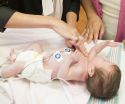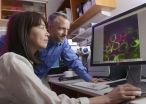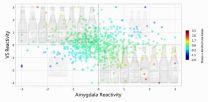(Press-News.org) ROCHESTER, Minn. - Opioid painkiller addiction and accidental overdoses have become far too common across the United States. To try to identify who is most at risk, Mayo Clinic researchers studied how many patients prescribed an opioid painkiller for the first time progressed to long-term prescriptions. The answer: 1 in 4. People with histories of tobacco use and substance abuse were likeliest to use opioid painkillers long-term.
The findings are published in the July issue of the medical journal Mayo Clinic Proceedings.
While the study identified past or present nicotine use and substance abuse as top risk factors for long-term use of opioids, all patients should proceed with caution when offered opioid painkiller prescriptions, says lead author W. Michael Hooten, M.D., an anesthesiologist at Mayo Clinic in Rochester.
"From a patient perspective, it is important to recognize the potential risks associated with these medications. I encourage use of alternative methods to manage pain, including non-opioid analgesics or other nonmedication approaches," Dr. Hooten says. "That reduces or even eliminates the risk of these medications transitioning to another problem that was never intended."
Discovering who is likeliest to end up using the drugs long-term is critically important due to the widespread problems associated with their misuse, he says.
"Many people will suggest it's actually a national epidemic. More people now are experiencing fatal overdoses related to opioid use than compared to heroin and cocaine combined," Dr. Hooten says, citing data from the Centers for Disease Control and Prevention.
Researchers used the National Institutes of Health-funded Rochester Epidemiology Project to get a random sample of 293 patients who received a new prescription in 2009 for an opioid painkiller such as oxycodone, morphine, hydromorphone, oxymorphone, hydrocodone, fentanyl, meperidine, codeine and methadone.
They found that 21 percent, or 61 people, progressed from short-term use to prescriptions lasting three to four months, and 6 percent, or 19, of the 293 studied ended up with more than a four-month supply of the drugs.
The identification of nicotine use and substance abuse as top risk factors for long-term use of opioids suggests that physicians should be particularly careful about prescribing the painkillers to patients with such histories, Dr. Hooten says.
Why is there such a connection? The science shows it's all in our heads. The neurobiology related to chronic pain, chronic opioid use and addiction is similar, Dr. Hooten says. For example, nicotine activates a group of receptors, or brain structures, in a way very similar to how opioids and chronic pain may activate them.
Long-term opioid use may actually make people more sensitive to pain - a condition called opioid-induced hyperalgesia, another recently published study by Dr. Hooten and other Mayo researchers found.
If opioids must be used, as is usually the case with surgery or traumatic injuries, reducing the dose and limiting the duration of use is important, Dr. Hooten says.
"The next step in this research is to drill down and find more detailed information about the potential role of dose and quantity of medication prescribed," he says. "It is possible that higher dose or greater quantities of the drug with each prescription are important predictors of longer-term use."
INFORMATION:
The Rochester Epidemiology Project is funded by National Institute on Aging grant R01-AG034676.
About Mayo Clinic
Mayo Clinic is a nonprofit organization committed to medical research and education, and providing expert, whole-person care to everyone who needs healing. For more information, visit http://www.mayoclinic.org/about-mayo-clinic or http://newsnetwork.mayoclinic.org/.
About Mayo Clinic Proceedings
Mayo Clinic Proceedings is a monthly peer-reviewed medical journal that publishes original articles and reviews dealing with clinical and laboratory medicine, clinical research, basic science research and clinical epidemiology. Proceedings is sponsored by the Mayo Foundation for Medical Education and Research as part of its commitment to physician education. It publishes submissions from authors worldwide. The journal has been published for more than 80 years and has a circulation of 130,000. Articles are available online at http://www.mayoclinicproceedings.org.
Premature babies are at an increased risk for developing autism spectrum disorder. But a small study indicates that preemies who avoid eye contact in early infancy are less likely to demonstrate symptoms of autism at age 2 than preemies who maintain eye contact during early interactions, according to new research at Washington University School of Medicine in St. Louis.
"Children with autism typically have challenges with social interaction and may avoid eye contact, but it turned out that children in this study who had characteristics of autism at age 2 were more likely ...
ROSEMONT, Ill.--Participation in sports by women and girls has increased from 310,000 individuals in 1971 to 3.37 million in 2010. At the same time, sports-related injuries among female athletes have skyrocketed. According to a new study in the Journal of the American Academy of Orthopaedic Surgeons (JAAOS), women with symptoms known as the "female athlete triad" are at greater risk of bone stress injuries and fractures.
"The female athlete triad is a spectrum of symptoms that include low energy availability, menstrual cycle abnormalities, and low bone mineral density. ...
There may be far fewer galaxies further out in the universe then might be expected, according to a new study led by Michigan State University.
Over the years, the Hubble Space Telescope has allowed astronomers to look deep into the universe. The long view stirred theories of untold thousands of distant, faint galaxies. The new research, appearing in the current issue of the Astrophysical Journal Letters, however, offers a theory that reduces the estimated number of the most distant galaxies by 10 to 100 times.
"Our work suggests that there are far fewer faint galaxies ...
People have evolved to be smarter and taller than their predecessors, a study of populations around the world suggests.
Those who are born to parents from diverse genetic backgrounds tend to be taller and have sharper thinking skills than others, the major international study has found.
Researchers analysed health and genetic information from more than 100 studies carried out around the world. These included details on more than 350,000 people from urban and rural communities.
The team found that greater genetic diversity is linked to increased height. It is also ...
The European Space Agency's Rosetta spacecraft first began orbiting comet 67P/Churyumov-Gerasimenko in August 2014. Almost immediately, scientists began to wonder about several surprisingly deep, almost perfectly circular pits on the comet's surface. Now, a new study based on close-up imagery taken by Rosetta suggests that these pits are sinkholes, formed when ices beneath the comet's surface sublimate, or turn directly to gas.
The study, which appears in the July 2, 2015 issue of the journal Nature, reveals that the surface of 67P/Churyumov-Gerasimenko is variable and ...
DALLAS - July 1, 2015 - UT Southwestern Medical Center scientists collaborating with University of Michigan researchers have found a previously unidentified mechanism that helps explain why stem cells undergo self-renewing divisions but their offspring do not.
Adult stem cells provide a ready supply of new cells needed for tissue homeostasis throughout the life of an organism. Specialized environments called "niches" help to maintain stem cells in an undifferentiated and self-renewing state. Cells that comprise the niche produce signals and growth factors essential for ...
DURHAM, N.C. - A pair of brain-imaging studies suggest researchers may be able to predict how likely young adults are to develop problem drinking or engage in risky sexual behavior in response to stress.
The new research is part of the ongoing Duke Neurogenetics Study (DNS), which began in 2010 to better understand how interactions between the brain, genome and environment shape risky behaviors that can predict mental illnesses including depression, anxiety, and addiction.
"By knowing the biology that predicts risk, we hope to eventually change the biology -- or at ...
GeoSpace
Beijing quadrupled in size in a decade, new study finds
Researchers tracked the changing physical infrastructure in Beijing, China, and found that the city's physical area quadrupled between 2000 and 2009, according to a new study published in Journal of Geophysical Research: Atmospheres.
Eos.org
Seismic Hazard Assessment: Honing the Debate, Testing the Models
Earthquake experts learn that "take a hike" isn't an insult, but a way to resolve hotly debated scientific issues. The scientists found common ground by trekking over it.
New research papers
Disappearance ...
For decades, researchers in the genetics field have theorized that the protein spools around which DNA is wound, histones, remain constant in the brain, never changing after development in the womb. Now, researchers from the Icahn School of Medicine at Mount Sinai have discovered that histones are steadily replaced in brain cells throughout life - a process which helps to switch genes on and off. This histone replacement, known as turnover, enables our genetic machinery to adapt to our environment by prompting gene expression, the conversion of genes into the proteins that ...
Washington, D.C., July 1, 2015--The vast majority of consumers recognize that multivitamins, calcium and/or vitamin D supplements can help fill nutrient gaps but should not be viewed as replacements for a healthy diet, according to a new survey conducted on behalf of the Council for Responsible Nutrition (CRN). Conclusions from the survey of more than 2,000 U.S. adults were published in Nutrition Journal in a peer-reviewed article titled, "Consumer attitudes about the role of multivitamins and other dietary supplements: report of a survey," authored by CRN consultant Annette ...



